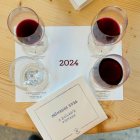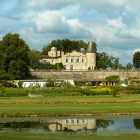
Sipping Through Time: A Wine Traveller’s Journey in Portugal
There’s a quiet magic to Portugal’s wine regions, sun-drenched vineyards cascading across ancient valleys, where centuries of tradition meet the pulse of modern winemaking. My recent journey through the Douro Valley and visit to Graham’s Port Lodge wasn’t just a tasting tour; it was a deep immersion into the soul of Portuguese wine.
The Grapes, the Ground, and the Glass: Understanding Portuguese Wine
The distinctiveness of Portuguese wine begins at ground level. A mosaic of terroirs, granite soils in the Dão, schist in the Douro, and limestone in Bairrada, combined with the country’s varied climate, gives rise to an astonishing diversity of wine styles. From cool, misty coastlines to sun-drenched interior hills, each region puts its unique stamp on the wine it produces.
What truly sets Portugal apart is its remarkable collection of native grape varieties, over 250 in total. Rather than following international trends, most winemakers proudly champion Indigenous grapes like:
- Touriga Nacional: Portugal’s signature red, prized for its intense colour, floral aromas, and robust structure.
- Tinta Roriz (Tempranillo): A versatile variety that adds body and spice, particularly in blends.
- Baga: A high-acid red from Bairrada known for producing complex, age-worthy wines.
- Alvarinho: Star of Vinho Verde, offering zesty, mineral-driven whites.
- Arinto and Encruzado: Crisp, aromatic white grapes with exceptional ageing potential.
The result? A dynamic portfolio of wines! Elegant yet powerful reds, fresh Atlantic whites, nuanced Tawny Ports, and sun-drenched fortified gems from Madeira and Setúbal. Each one expresses not just a grape or region but a deep-rooted sense of place and authenticity.
The British and the Birth of Port
No story of the Douro is complete without acknowledging Britain’s pivotal role in the development of Port. Ironically, it was a conflict with France in the late 1600s that prompted British merchants to seek alternatives to claret and led them upriver into the wild, rugged Douro.
In 1692, a British merchant named Job Bearsley stumbled upon a bold local wine crafted by Jesuits. Grape spirit was later added mid-fermentation to stabilise the wine for its long journey to Britain, marking the birth of what we now recognise as Port.
Demand soared, especially after the Methuen Treaty of 1703 established favourable trade ties with Portugal. Port quickly became a fixture in British cellars, with rituals like vintage declarations, corkscrews, decanters, and even the cylindrical bottle design emerging during this period. The British fascination with ageing and cellaring Port helped elevate it to international acclaim.
Their impact extended to the landscape itself. Galician stonemasons, driven by demand and dynamite, sculpted the dramatic schist terraces that still define the Upper Douro.
As Christian Seely of Quinta do Noval once said, “Talk about shaping the wine world in the most literal sense of the word.”
That same spirit of transformation and reinvention still runs through the Douro today. As Douro winemaker Dirk Niepoort puts it, “the Douro is the new world of the old world.” His words reflect the region’s dynamic evolution, where centuries-old vineyards embrace cutting-edge thinking.
First Stop: Graham’s Port Lodge
Perched on the hills of Vila Nova de Gaia, Graham’s Port Lodge overlooks Porto’s terracotta rooftops and the winding Douro River below. When you step inside, the cool air carries the sweet, earthy scent of ageing oak and fortified wine, an atmospheric introduction to the history housed within its cellars.
Founded in 1820, Graham’s is a cornerstone of the Port world. Our guided tour led us through cavernous cellars stacked with barrels and vats, each one a quiet testament to patience, craftsmanship, and time.
It was fascinating to see tradition and innovation side by side, ancient barrels sharing space with robotic treaders designed to mimic the gentle press of feet on grapes. Don’t forget your camera! The view from Graham’s terrace is postcard-worthy.
Tasting Flight Through Graham’s Best
The tasting was nothing short of extraordinary, a journey through some of Graham’s finest Tawny and Vintage Ports:
- 1997 Single Harvest Tawny: Lush and mellow, offering dried fig, orange peel, and a touch of warm spice.
- 30-Year-Old Tawny: Silky and refined, with layered notes of walnut, caramel, and a subtle tobacco edge.
- 40-Year-Old Tawny: Deep and complex, revealing almond, toffee, and citrus peel with remarkable freshness.
- 1994 Vintage Port: Powerful and brooding, yet elegant, an iconic vintage still evolving beautifully.
- 2000 Vintage Port: Rich and generous, showing ripe dark fruit, dark chocolate, and hints of herbs.
- 2016 Vintage Port: Bright, floral, and bursting with fruit, a youthful wine with a long life ahead.
Each glass told a story, not only of a particular year but of Graham’s enduring dedication to quality and the unique character of the Douro.
Planning a visit? Be sure to book tastings in advance, especially at iconic lodges like Graham’s, where availability can be limited during peak seasons.
Into the Douro Valley
Leaving Gaia behind, I followed the Douro eastward, deeper into Portugal’s most dramatic wine country. The drive alone was breathtaking! Steep vineyard terraces tumble toward the river, stone walls catch the sun, and quintas emerge like secrets among the hills.
The Douro is no longer just Port country. In recent decades, the region has gained international acclaim for its dry wines, from bold Touriga Nacional reds to crisp, mineral whites made from Rabigato and Viosinho. Visits to family-run estates offered a glimpse into the valley’s rugged beauty and deep-rooted traditions.
One golden afternoon, perched on a hilltop vineyard, glass in hand and river below, I was struck by the rhythm of life here. Time slows. The wine, the stories, the scenery, they all ask you to linger just a little longer.
A Living Landscape of Global Significance
But the Douro Valley isn’t just beautiful; it’s recognised by UNESCO as a World Heritage Site and is celebrated for its extraordinary cultural landscape shaped by two thousand years of winemaking. Terraced vineyards carved into schist slopes, dry-stone walls known as ‘Socalcos’ and historic ‘Quintas’ speak to the ingenuity and endurance of generations of farmers.
This is a region still actively farmed, still producing wine with the same methods that shaped the land. From whitewashed villages to chapels perched on hillsides, the Douro is a living, working testament to the harmony of nature, culture, and craft.
The best time to visit? September to October during harvest, when the valley buzzes with activity and the light is golden.
Why Portugal Should Be on Every Wine Lover’s Radar
Portugal remains one of the wine world’s best-kept secrets. For those willing to explore beyond the usual routes, it offers an unforgettable blend of history, authenticity, and hospitality.
Whether you’re tasting century-old Ports in Gaia, walking vineyard trails above the Douro, or sipping a zesty Vinho Verde by the Atlantic, Portugal invites you to slow down and savour. And unlike some of its more polished counterparts, it’s the little imperfections, the winding roads, rustic quintas, and warm welcomes that make the journey so unforgettable.
As I departed the Douro Valley, the lingering taste of aged Tawny and the warmth of its people stayed with me, a reminder that great wine, like great travel, lives long in the memory.
Related Articles

Bordeaux En Primeur 2024 Vintage: A Detailed Analysis
By Tom Gearing







